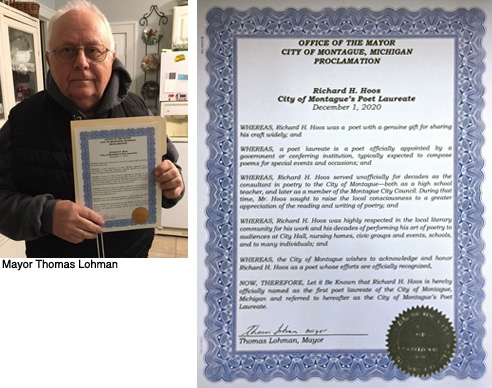A Brief History of Montague
In 1642, at White Lake, a Jesuit Priest recorded the massacre of a tribe of Pottawatomi Indians by a tribe of Neuter Indians. The name, “White Lake” was interpreted by Father Pere Marquette, who stopped at the lake in 1675, from the Indian name of “Wabish-Sippe,” meaning the river with white clay in the water. Even today, marl-clay lies in the bed of the river and lake. Climate and water made the Montague area an attractive site for Indian settlements.
The first white settler in Montague was Job Sargent, a hero of the War of 1812, who was granted a quarter section of land in the Northwest Territory (now Michigan), in recognition of his bravery and heroic service. In 1817 he visited his land and in 1850 his son Nathan built a cabin, the first building where Montague now exists, one of a family of nine children. The site is now a City Park and contains information about Mr. Sargent and the World’s Largest Weathervane.
With vast pine forests all around, the first lumber mill, the “Ferry Mill” was built in 1850 and each year another mill was added to the lake until 16 mills were operating. In 1868 a large iron foundry was opened to build steam marine engines and machinery for the many mills. Even today, Montague is home to the largest modern aluminum foundry producing weathervanes, signs and other garden and yard ornamentation.
Montague was platted in 1867 by Reverend William Montague Ferry, Anders Knudsen, and Even Knudsen. As part of the platting for the original Village, the streets of Montague were named in honor of several Civil War heroes and in memory of his son Noah. In 1862 Reverend Ferry’s son, Noah, had mustered a group of young men and they entered into the Army to fight in the Civil War. Noah, promoted to Major, was killed at the Battle of Gettysburg. The Post Office opened in 1867 and by 1870 the village was thriving as a center for lumbering and manufacturing. Lumber cut in the mills on White Lake helped to rebuild Chicago after the great fire of 1871. Some mills cut as much as 50,000 board feet in one 12-hour day.
The Village of Montague became a Fifth Class City in 1935 and has adjusted to change with calm and a forward-looking resolve to maintain its uniqueness as a friendly, small community.
Written by Henry E. Roesler, Jr., former Mayor
Construction of Town Hill – circa 1900

The Franklin House (Hotel) – circa 1911

The Franklin House (Hotel) – circa late 1950s

The Franklin House (Hotel) – circa 1961
» White Lake Beacon article (PDF) 8/9/99

Aerial photo – circa 1965

The Flood of 1978

Flooded Chimont Facility – Photo by Charles Mindham
As darkness began to fall on the White Lake Area on August 18, 1978, so did the rain. In the following few hours over 7-inches of rain fell. The rain and run-off caused Buttermilk creek to swell. Buttermilk Creek, which is also part of the County drainage system, flows in a ravine from its origin at Eilers Road. The creek then enters a 52-inch concrete culvert behind the Post Office and flows under Ferry and Water Streets and empties out behind what is now Montague Foods. But on that night, there was just way too much water for the tube to handle. The creek spilled over its banks upstream from the tube and flooded the adjacent Chimont facility. The creek also flooded the local grocery store, Miller Foods, which lies adjacent to the tube. The storm also caused portions of Cook Street and Old Channel Trail to wash-out.
In 2003, the City of Montague received a $250,000 grant from FEMA to purchase the “Chimont Property” and removed the structure from the flood plain. The City plans to turn this site into a park someday.
The Day the Bear Came to Town

On the evening of May 3, 1999 a young black bear was spotted coming out of the wetlands behind the Ellenwood Landing storage buildings at the south end of Water Street. The bear headed up Church Street strolling past the Farmers’ Market. He then headed north on Ferry Street right into the heart of downtown. With a police escort, the bear crossed Dowling Street and continued north on Ferry Street taking a left at Dahl’s Tri-County Feed Store and went up the Hunt Street hill (see photo). The bear continued north on Stebbins Street and across Stanton Boulevard until he went down into the ravine at the end of Stebbins, never to be seen again.
Richard H. Hoos, the City of Montague’s Poet Laureate
On December 1, 2020, Mayor Tom Lohman made a Mayoral Proclamation naming Richard H. Hoos as the City of Montague’s Poet Laureate. Dick had served unofficially for decades as the consultant in poetry to the City of Montague–both as a high school teacher, and later as a Montague City Council Member. Our good friend, Dick Hoos, passed away on November 22, 2020. He left an indelible mark on our community. He will be deeply missed. However, he will forevermore be remembered in our hearts and officially as the “City of Montague’s Poet Laureate.”

